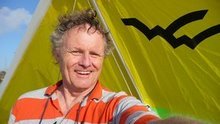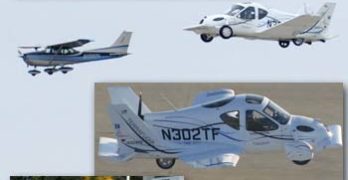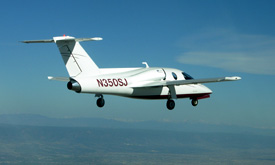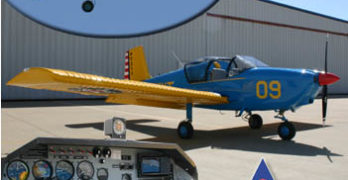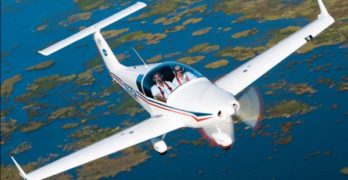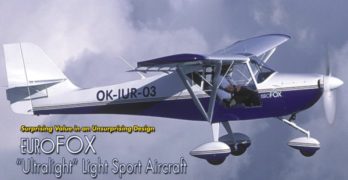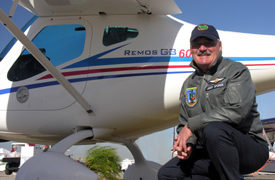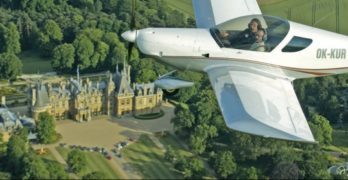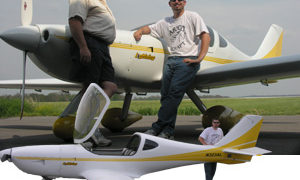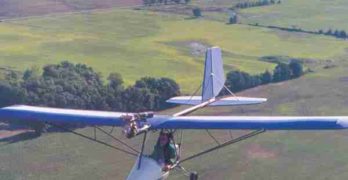Greetings fellow LSA fans! *** Welcome to Hangar Flyin’ *** I’m Jim Lawrence, *** Light Sport Editor at Large *** We’re starting this blog so you’ll have a webby place for your questions, burning issues, rants (keep ’em clean) and for when you just feel like dropping by to stay in touch. We’re up, and we’re listening. *** Let us know how you feel about the LSA coverage in the magazine and here. Hope to see you in the skies this year. *** High and safe, *** Jim *** =================================================== *** To start things off right, here’s a couple shots of the bird I trained in: *** ——— the lovely Flight Design CTLS. *** It’s a wonderful example of the new wave of LSA machines: strong, responsive, comfortable, with great range, sturdy gear and real cross country legs with its 120 knot speed and 1000 mi range. *** Into the hangar before the next storm *** Sleek, pretty and sweet to fly… *** My flight instructor John Lampson.
Search Results for : Flight Design
Not finding exactly what you expected? Try our advanced search option.
Select a manufacturer to go straight to all our content about that manufacturer.
Select an aircraft model to go straight to all our content about that model.
Terrafugia Escapes Terra Firma on First Flight
Massachusetts-based Terrafugia announced today the first flight of its proof of concept Transition “roadable aircraft.” The maiden flight occurred on March 5th and followed six months of static, road, and taxi testing. Transition made its first escape from Earth at the Plattsburgh, New York airport, flown by retired Air Force colonel Phil Meteer who reported, “Transition flew like a really nice airplane.” *** Terrafugia said their Transition can cruise 450 miles at 115 mph and can drive at highway speeds on the road. Designers say it fits in a standard home garage. Transition uses front wheel drive on the road; both ground and flight modes are powered by the 100-hp Rotax 912S. Terrafugia CEO Carl Dietrich said that transforming Transition from plane to car takes the pilot a mere 30 seconds. Then you can drive your airplane off the airport to a local gas pump and fill up at a substantial discount to 100LL avgas (see inset photo of Dietrich at gas station).
First Flight for Excel’s Single Engine Sport-Jet
OK, as with last summer’s SPLOG on SpaceShipOne, news about a jet may seem odd on a website about Light-Sport Aircraft. Well, it does have “Sport” in its name and it is the lightest of the new flock of Very Light Jets (VLJs). But mainly, I just think this is an impressive development of an American-made single engine jet. Sport-Jet is one spacious, high-performing jet aimed at regular GA pilots. About his first flight, pilot Ron McElroy said it was, “…like shooting a BB out of a slingshot!” Developer Bob Bornhofen and his small, highly-focused team were all smiles. Unlike projects like Eclipse, built on a massive $400 million investment or Cessna, backed by a huge conglomerate, Excel-Jet is more an efficient “skunk works” project. Team Excel flew Sport-Jet within two weeks of delivery of their Williams jet engine. First engine start and taxi tests commonly take 2-3 months.
Flight School Economics – IndUS Primary Trainer
I’ve lost track of the model count for Cessna’s 172, but the lesson of specifying an airplane to a task is not lost on IndUS Aviation. During Oshkosh, marketing man, Scott Severen announced the Thorpedo PT…not PT as in “Cruiser,” but Primary Trainer. Nor is it the Thorpedo LP, the company’s earlier model designation for LoPresti-inspired speed mods and visual enhancements. That variation was about gaining speed, where the PT suggests a basic flight trainer. *** Increasingly, mainstay LSA producers like IndUS are refining their product for instruction. Severen explained the cost effectiveness of the new PT model, “Savings are derived from are the four cylinder 85-hp Jabiru engine, which only burns 3.5 gallons per hour. With a lower cost TBO of 2000 hours coupled with the easily maintained all-metal airframe you have profitable trainer on the flight line.” *** My experience with the 80-hp Jabiru on the SkySkooter shows it to be capable in all but high elevations and then still markedly better than, say, a Cessna 150.
Canadian-Designed Czech-Built Skylark
A Doubly International LSA
SportsPlanes.com imports several
light-sport aircraft (LSA)
that have found ready buyers.
After researching through
several designs, SportsPlanes’ owner
Josh Foss originally settled on the
Comco Ikarus C42 and Breezer and
the U.S.-built American Flyer for its
fleet. Most recently, the company
added the Czech-built Dova Skylark
to its offerings.
However, the real story of this company
is not Josh Foss’ care in the selection
of what airplanes to sell. What
may be more important to the marketplace
is the network his company
has built to bring service and support
to SportsPlanes.com’s customers.
Currently, 15 SportsPlanes centers are
operating, with the goal to establish
25 centers nationwide.
Investigating the Skylark
My opportunity to fly the Skylark
came while attending the U.S. Sport
Aviation Expo in Sebring, Florida, in
January. I flew with Darrell Hamilton,
the SportsPlanes representative
for Florida.
Darrell retired from Northwest
Airlines four years ago. He most recently
crewed the fly-by-wire Airbus
A320, which needs only small control
movements.
Surprising Value in an Unsurprising Design
On September 1, 2004, when the Federal Aviation Administration (FAA) released the long-anticipated Sport Pilot and Light-Sport Aircraft regulations, a new aviation segment called light sport aircraft (LSA) was created. Some saw LSA as a bridge between ultralights and general aviation aircraft, but are LSA so different from ultralights? The answer is a mixed yes and no.
Yes, many aircraft look different in that the extra weight they may possess allows them to have full composite fuselages, a panel full of instruments even including fancy glass cockpit hardware, plus they can be delivered ready to fly even as 2-seaters. That’s different than our ultralight trainers or our amateur-built recreational aircraft that resemble those trainers. Prices for these light sport aircraft have pushed them beyond the budgets of many pilots.
On the other hand, these aircraft needn’t be all that different from ultralights. The new rule doesn’t require that they weigh the maximum 1,320 pounds.
Sleek Design Is Workhorse; Remos G-3 “Trainer”
Rob Rollison imports the gorgeous Remos G-3. [2007 UPDATE: The new importer is Remos USA. Call: Toll Free: 888-838-9879] He is working closely with German designer Lorenz Kreitmayr to certify G-3 as a Special Light-Sport Aircraft. Early sales will be to sophisticated buyers that see the sleek machine as a personal aircraft with impressive performance. But at the Sebring Expo 2006, I met a German instructor who sees it differently. Josef Sporer somewhat hesitantly bought a G-3 to see if it would work in his flight school. After an astounding 20,000 landings and 3,500 hours on one aircraft, he is so convinced of the aircraft’s sturdiness for instructional use that he’s added a second one. So while the Remos aircraft looks like a dream, and boasts good gliding and cruising performance, it qualifies quite well as a trainer, too. Built since 1997, more than 164 are flying around the world.
Czech SportCruiser, Custom-Designed for Americans
Czech Aircraft Works (CZAW) began life in the newly
freed Czech Republic not long after the history-making
fall of the Berlin Wall in 1989. Tapping a wellspring
of aeronautical training and experience that became
available when the Soviets pulled out of the former
Czechoslovakia, American owner Chip Erwin started
CZAW in 1992. Using the highly trained but lowcost
labor force available, Erwin manufactured parts
for and assembled the CH 601 and CH 701 designs of
Chris Heintz’s Zenair Ltd. The young company found
a solid market in Europe for fully built CH 601s and
CH 701s. Each year it grew in size and built ever more
of the all-metal designs.
As CZAW increased its production
capability, it began to explore designs
of its own. It found success first with
its Czech Floats; many American
aircraft are fitted with this all-metal
amphibious system. Three years ago,
CZAW partnered with Sport Aircraft
Works (SAW) of Palm City, Florida,
led by Danny and Zaneta Defelici,
to pursue the development, sales,
and marketing of light-sport aircraft
(LSA).
Aircraft Design Holy Grail…& Arion’s Lightning
A standard measuring stick for aircraft design is the ratio of minimum speed to maximum speed. Powerful jets like the Blue Angels’ F/A-18 (along with a government credit card to fuel them) can perform in airshows from 120 mph to 700 mph, almost a 6:1 ratio. But for airplanes you and I can afford, a ratio greater than 3:1 is good with 4:1 being the holy grail. In my experience, a 4:1 ratio is rare; a LSA that stalls at 40 knots and tops out at 120 knots represents only 3:1. *** Recently I flew the Arion Aircraft Lightning. Yielding a fine experience with quick yet stable handling, short takeoffs and easy landings plus mild stalls, Lightning also proved a handsome performer. Nick Otterback reports flying Lightning to better than 200 mph and I held around 40 mph in slow flight. Even assuming instrument error at slow speeds, that’s still well beyond the 4:1 ratio.
Flightstar Classic
A great old name has returned! The Flightstar is back. Actually, the design has survived various ownership changes quite well. The original Pioneer Flightstar became the Argentine Aviastar. Now original designer, Tom Peghiny, has bought the plane and the name.
It’s all-American again, too, made in the USA. Above you see the F.A.R. Part 103-legal version, the Flightstar Classic. The Classic has a big brother single seater and of course, a two-seat trainer. The Classic is the company’s primary fun machine, though.
All the Flightstars were designed under accepted engineering methods. They’ve also been given the touch by Peghiny, an ultralight pioneer who aviation business experience dates back to his teens. It’s easy to see this successful combination if you examine individual component design and finish.
The Flightstar has an avid following of five hundred owners who love the way their planes fly. The Classic has simple features and low price while maintaining wonderful handling qualities.
- « Previous Page
- 1
- …
- 9
- 10
- 11
- 12
- 13
- …
- 148
- Next Page »


